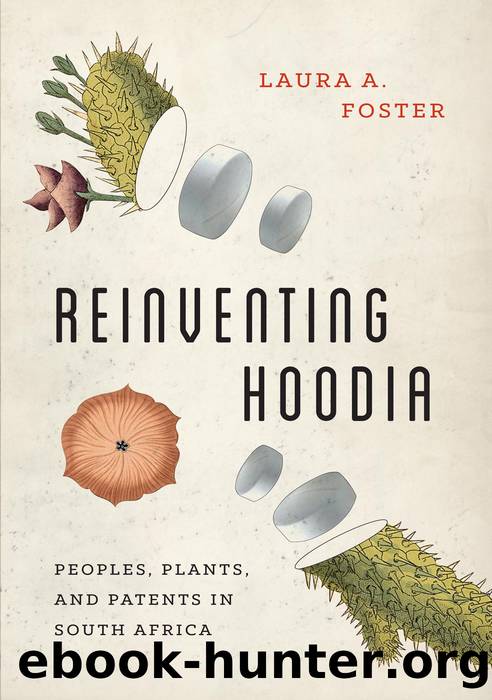Reinventing Hoodia by Foster Laura A

Author:Foster, Laura A.
Language: eng
Format: epub
Publisher: University of Washington Press
Published: 2017-06-14T16:00:00+00:00
Situating Hoodia: Afrikaner Histories of Indigeneity and Belonging
To understand the growers’ motivations for entering the Hoodia market and forging a benefit-sharing agreement with San peoples requires first understanding the history of Afrikaner colonial settlers and their shifting relations to the nonhuman and to indigenous peoples.2 As mentioned in chapter 1, Afrikaners are descended from Dutch, German, French, and Scottish colonialists who began arriving in the Cape region in the seventeenth century. Initially fearing the strange lands and peoples they encountered there, these white settlers committed acts of violence against Indigenous San and Khoi peoples that they justified as necessary to their survival as settlers.3 Once they had established control over the region’s land and peoples, these settlers began to develop a sense of belonging through a romanticized connection to the land. Having left their European past behind, they began to imagine an indigenous relationship to their newly conquered territory—to develop what Saul Dubow terms an “acquired indigeneity.”4
This Afrikaner indigenized identity was built on a religious connection to the land and symbolic kinship with plants and animals—connections that worked to establish belonging. To assert their rights and control over the land, these Afrikaner colonial settlers characterized South African territories as having previously belonged to no one. Considering themselves chosen by God to rule South Africa, they worked the land and understood their bodies as molded into the landscape.5 Their sense of belonging to the land did not include the indigenous peoples they encountered, whom they considered incapable of working the land and thus unable to fashion an attachment to it.6 This indigenized Afrikaner identity arose in opposition not only to indigenous peoples, but also to later colonial settlers as they faced violence and imprisonment at the hands of British troops.
Afrikaner settlers’ sense of belonging was thus based on viewing land, plants, and animals not as inert and passive entities but as central to their identity and humanness. In contrast to San and Khoi understanding of the nonhuman through notions of kinship—the nonhuman as familial relatives and ancestors, as expressed in the posters in the SASI offices described earlier—Afrikaner identity and belonging was contingent on their interdependent relationship to land, animals, and plants they viewed as natural, God-given gifts to be controlled by humans. Afrikaner identity thus developed out of a multispecies understanding of the world, but one that continued to deny agency to nonhumans and to the indigenous peoples they encountered.
This Afrikaner sense of belonging took on greater importance and unity with the 1948 establishment of apartheid, which formalized white supremacy in the name of Afrikaner identity and a historical connection to South African lands. Apartheid privileged whiteness by dissolving the distinctions between Afrikaner and British that had earlier fueled Afrikaner nationalism.7 South Africans who identified as Afrikaner or English benefited from apartheid divisions of white and nonwhite that granted them political, economic, and legal advantages. The end of apartheid, however, brought an end to the political and legal control of white South Africans, who also perceived this shift as a
Download
This site does not store any files on its server. We only index and link to content provided by other sites. Please contact the content providers to delete copyright contents if any and email us, we'll remove relevant links or contents immediately.
| Acupuncture & Acupressure | Aromatherapy |
| Ayurveda | Chelation |
| Chinese Medicine | Energy Healing |
| Healing | Herbal Remedies |
| Holistic | Homeopathy |
| Hypnotherapy | Massage |
| Meditation | Naturopathy |
| Reference |
Inner Engineering: A Yogi's Guide to Joy by Sadhguru(6758)
The Power of Now: A Guide to Spiritual Enlightenment by Eckhart Tolle(5683)
Fear by Osho(4702)
Ikigai by Héctor García & Francesc Miralles(4177)
The Art of Happiness by The Dalai Lama(4099)
The Ultimate Bodybuilding Cookbook by Kendall Lou Schmidt(3909)
Yoga Therapy by Mark Stephens(3723)
The Little Book of Hygge by Meik Wiking(3665)
The Healing Self by Deepak Chopra(3532)
Why Buddhism is True by Robert Wright(3426)
The Hatha Yoga Pradipika (Translated) by Svatmarama(3285)
Being Aware of Being Aware by Rupert Spira(3248)
Shift into Freedom by Loch Kelly(3168)
Wild Words from Wild Women by Stephens Autumn(3118)
Work Clean by Dan Charnas(3081)
Happiness by Matthieu Ricard(3024)
More Language of Letting Go: 366 New Daily Meditations by Melody Beattie(3005)
Yoga Body & Mind Handbook by Jasmine Tarkeshi(2850)
Why I Am Not a Feminist by Jessa Crispin(2727)
